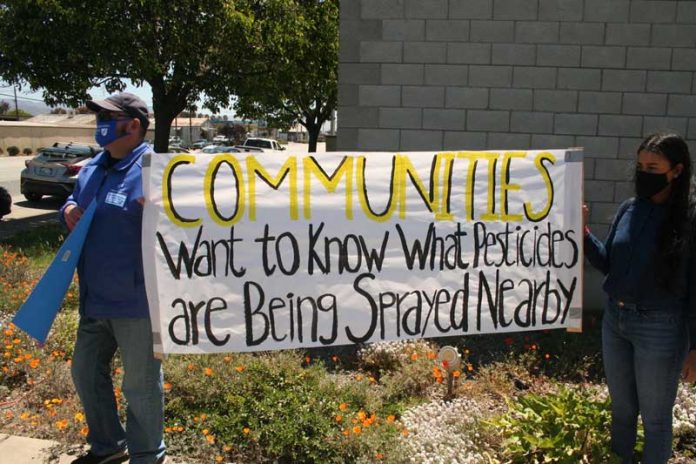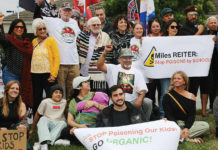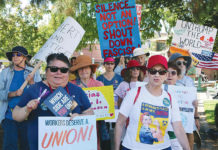By Jane Sellen
[Note: Other members of Californians for Pesticide Reform contributed to this report]
SALINAS—On May 27 dozens gathered at the Monterey County Agricultural Commissioner’s office in Salinas, calling on the state and county governments to web-post advance warning of agricultural pesticide use.
The event was one of several by farmworking communities across California who joined together in person and online to call for pesticide notification, citing health impacts of pesticide exposure and the tendency of pesticides to drift far from where they are applied.
According to Safe Ag Safe Schools, currently, no notice is provided to the public. Advocates say that knowing in advance about hazardous chemical use near homes and schools would enable residents to take steps to protect themselves and their families from harm.
In Salinas, a crowd of 30 listened to local leaders, including Dr. Ann Lopez of the Center for Farmworker Families, Lauro Barajas of the United Farm Workers, Greenfield City Council Member Yanely Martinez, Demetrio Pruneda of Safe Ag Safe Schools, Veronica Diaz of the Monterey Bay Central Labor Council and Karen Araujo of the Unitarian Universalists’ Social Justice Committee, who read a statement of support from retired State Senator Bill Monning.
The crowd then marched to the Ag Commissioner’s office as a delegation, but the doors were locked and those inside refused to respond, Safe Ag Safe Schools said in a press release. A letter signed by the delegation was sent to Monterey County Ag Commissioner Henry Gonzales.
The statewide event, organized by Californians for Pesticide Reform, marked the birthday of Rachel Carson, whose book Silent Spring, published almost 60 years ago, exposed the health and environmental harms of DDT and other pesticides that leave a legacy of destruction. The event included a virtual online rally and simultaneous on-the-ground community delegations to County Agricultural Commissioner offices in Salinas, Bakersfield, Modesto and Tulare. In addition, more than 23,000 signed a petition calling for public notice.
More than 200 million pounds of pesticides are used in California each year, with roughly 20% known to cause cancer and many linked to a variety of health impacts including asthma, autism, Parkinson’s and developmental and reproductive harms. Many pesticides are known to drift far from their intended target, some traveling miles from treated fields.
In Monterey County, a limited pilot program provides advance notice of agricultural fumigant applications within a quarter-mile of 10 schools in the northern part of the county. Fumigants are just one category of pesticides that accounts for 38% of agricultural pesticide use in Monterey and Santa Cruz counties combined (2,983,217 of 7,917,292 lbs in 2018).* Fumigants can drift for miles beyond the quarter-mile notification area. The pilot program also requires residents to opt in to receive alerts, and the agricultural commissioner has resisted calls to expand it to all schools in the county, says Safe Ag Safe Schools organizers. Advocates for increased transparency say the program is far too limited in scope, and the opt-in requirement falls short of making pesticide use data public in advance.
As a first step toward a comprehensive statewide notification system, advocates are calling for advance online publication of “Notices of Intent” (NOIs), forms which growers must submit to county agricultural commissioners before they are permitted to use pesticides classified as Restricted Materials, those considered to be the most hazardous or drift-prone.
“NOIs are available to the public on request after the fact. That’s too late for people living in farmworker communities—living in these sacrifice zones,” said Héktor Calderón, coordinator of the local Safe Ag Safe Schools coalition. “We’re demanding the state require this information to be made public beforehand, so that people can take precautions for themselves and their families. Continuing to allow the secret use of drift-prone hazardous chemicals is a serious and ongoing threat to public health.”
The cities of Watsonville, Greenfield and Soledad, as well as the Greenfield Union and Pajaro Valley Unified school districts have all passed resolutions calling on Monterey and Santa Cruz counties to web-post NOIs as a first step toward increased transparency. These governmental bodies and local advocates argue that making NOIs public in advance is a simple, low-cost form of notification that builds on existing notice provided by growers to agricultural commissioners and imposes no new demands on growers. Notification would enable residents to take preventive measures such as closing windows, keeping asthmatic children indoors or refraining from hanging laundry outside. Publicly available notice would also enable scientists to plan air monitoring for times when exposure is most likely to be measured.
“We call on Monterey County Ag Commissioner Henry Gonzales to lead the way for California in providing notice to communities before toxic chemicals are sprayed around our homes and schools,” said Greenfield City Councilmember Yanely Martinez. “Three of our cities, including my own, and two school districts have already called for it, and it’s the right thing to do. This is a simple and cost-effective measure we can take right now to better protect our health.”
The California Department of Pesticide Regulation has announced plans to develop a statewide notification on regulation, and the Governor’s revised budget, announced last week, includes $10 million for that purpose, outlining a regulatory process that will extend through June 2024. However, advocates argue that NOIs are public documents that can be made public now, without spending years on the regulatory process. Previous efforts by DPR to develop a notification rule in 2016 quickly withered under a blast of opposition from industry, which adamantly opposes any move toward greater transparency.
“Agricultural commissioners act under the direction and supervision of the director of the Department of Pesticide Regulation. The state can use its existing authority to require county agricultural commissioners to post NOIs in advance on a public website,” said Paulina Torres, staff attorney with Delano-based Center on Race, Poverty and the Environment. “Since no burden would be placed on growers and pesticide applicators, no regulation is needed. The time to require more transparency is now, not years from now.”
Click here for figures from California Department of Public Health’s Pesticide Mapping Tool.












